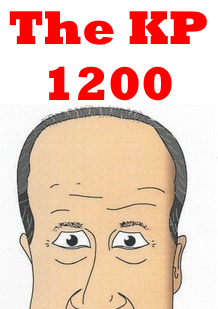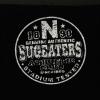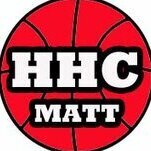Then & Now: Larry Cox
Compiled By Dave Brandon
(Photo Courtesy NU Media Relations)
Basketball Hall of Famer Larry Cox played for the
Huskers from 1974-1976, and is the all-time leader in
field goal percentage at Nebraska (.672). Cox also was
the Big 8's all-time leader in the same category.
Cox, who is 44th on the all-time
Husker scoring list (757 points), is a former Academic
All-Big 8 in addition to his accomplishments on the
court under the late Joe Cipriano.
The 6'6" Cox, who played center at
Nebraska, is our latest guest in this Sunday's edition
of "Then & Now".
HHC: Welcome aboard.
When was the last time you talked some Nebraska
basketball?
LC: Oh golly, a longtime. I think its been
years. Every once in awhile, it comes up around here
(Indiana) because Jack Moore is from Muncie, and Brian
Carr coaches around here in the high school ranks.
Actually, just this morning, a guy came up to me while I
was working out and said, “You know Jack Moore is from
around here and Brian Carr is still in town.” So, it
does come up from time to time, but not much.
HHC: You came to Nebraska in 1972, and
arrived from Thomas Jefferson High School in Denver
(Colorado) where you were an All-City performer. What
made you choose Nebraska, and who else recruited you?
LC: I was recruited by the University of
Missouri and Colorado. But, some place in the middle of
the recruitment process, both of them decided I wasn’t
big enough and quick enough, so they dropped off
somewhere in my senior year, and Nebraska was really the
only one that stuck with me all the way through.
HHC: Phil Chambers, Rickey Harris, and
yourself were all from Denver and played at the same
time. Was that pure coincidence, or was there some sort
of connection from one of the coaches?
LC: Well, Lonnie Porter was one of the
assistants, along with Moe (Iba), and he was from a high
school (Manual High School) in Denver. He didn’t have
anything to do with me, but definitely Phil Chambers and
Rickey Harris were his connections.
HHC: What was the perception of Nebraska
basketball back then to a high school kid from Denver?
LC: (Laughs) I was really naïve. I knew
nothing outside of my own city. I didn’t even know that
Nebraska had been #1 in football the year before, so I
had no perception of anything anywhere. I actually
thought Nebraska was somewhere around Arkansas, and I
thought I was going someplace warm. And I showed up on
campus my first winter and said, “What did I do to
myself here?” (Laughs)
But as it turned out, it was a
great choice for me, but I had no perceptions before.
HHC: Talk about the late Joe Cipriano,
both as a man and basketball coach.
LC: I really liked
Joe. Joe was funny and always doing extravagant things.
He was just kind of a dandy… Sort of always thinking
about stuff. He always seemed to buy new shoes, and I
got along with him real well. He was good at recruiting
and good at public relations, and just a nice man. I was
sorry to see him pass.
And, I had a pretty good
relationship with his son, Randy.
As far as on the court, I think he
was influenced quite a bit by Moe Iba’s style. Moe
brought the theory to the basketball team and made sure
we played tough defense. Joe, I think, emulated Bobby
Knight somewhat with that style of play. Of course we
never had the talent or size of Indiana schools, but he
was a good coach and very flamboyant, and fun, to play
for.
HHC: What are your favorite memories of
him?
LC: One of my favorite memories was one
time he got real upset and things weren’t going our way,
and he went on the court and was circling in this
pinkish/purple sports coat, and he swinging it over his
head and got a technical foul, which I think was at
Kansas, who he especially hated.
Actually, he’d made us go out
during the “Rock Chalk Jayhawk” chant and have us go
around the Jayhawk during that and dribble just to get
them to boo, and he’d go talk to them and egg them on
more.
HHC: (Laughs) Classic. You were a little
bit undersized to be a center at 6'6", but led the
Huskers in rebounding in 1976 and led the Big 8 in field
goal percentage in 1975. What made you play bigger than
you were?
LC: Hmm… That’s a great question. I think
I was really a role player and our offense was a very
set offense. So, as long as you told me where to go or
whom I was supposed to pass to, I was okay.
I was never really a good one on
one or individual player, like Marsh or any of those
guys. I was a role player, and I tried to do what the
coaches said. And, Coach Iba had us playing good defense
and in good position for rebounds, and so I just tried
to follow the plan.
HHC: Your first year at Nebraska was
1972-1973, and it was spent on the JV team, where you
averaged 19.4 PPG and 16.5 RPG. At that time, were you
forced to play on the JV team one year before you could
play varsity, or what was the reason for you not being
on varsity?
LC: What happened was they had some really
talented guys ahead of me. They had Ron Taylor, he was
6’10”. Mark… from Iowa… I think it was Enright, and he
was there that year. And then I think Brendy Lee was
still there, and Don Jackson.
So, they had some people ahead of
me, and I was like the fourth center. Playing on the JV
was a way of keeping me active and playing.
HHC: 1973-1974 was your first year on the
varsity team, and you guys went 14-12 (7-7). You
averaged 7.0 PPG and 4.4 RPG, and the team got to travel
to Italy following the season for three weeks, where you
guys went 2-5. What was that experience like?
LC: You know, I didn’t even make the trip.
I opted out and missed out, and heard it was quite a
trip. Lots of Bob Siegel stories about monks and
monasteries, lots of things, but I wasn’t there
(Laughs).
HHC: (Laughs) In 1974-1975, you guys again
went 14-12 (7-7), and lost three Big 8 games by a
combined four points. Individually, you led the Big 8 in
field goal percentage, and the team in free throws. What
do you remember about that year?
LC: They all blend
together now, all those years… Boy.
(Long Pause) I guess I remember the
sense at the end of the year that we were improving and
getting better, and that we were close. And I enjoyed
that year especially because Kent Reckewey and Steve
Erwin were older, and just being around them and having
those friendships.
HHC: 1975-1976 was
your last year at Nebraska, and the team went 15-14
(7-7), while you led the team in field goal percentage,
rebounds, and free throw shooting. Your team also led
the Big 8 in scoring defense and finished eighth
nationally. What made that team so good defensively, and
how big of a role did Assistant Coach Moe Iba play in
that?
LC: I think we played
a very tough, aggressive defense, and we slowed the ball
down. We played hard-nosed, man-to-man defense, and
especially for a post on the inside, we worked a lot at
not getting caught or pinned by the big man. I was
always moving around and trying not to get touched or
pinned with an elbow so we could steal the ball and keep
them from it, so we spent a lot of time on defense.
HHC: You finished
your career as the Big 8's all-time leader in field goal
percentage. What made you such a good finisher, and how
big of an honor was that?
LC: It was a tremendous honor. And the
funny thing is people think of the percentage that I
made, but if you think about where I was shooting from,
the question is how could I have missed 33% of those?
(Laughs) They were all put backs and dump offs, and I
was trying to tell my son that I don’t remember a single
move I ever put on somebody. All my scoring was
offensive rebounds and put backs.
HHC: (Laughs) You are
way too modest.
LC: It’s the truth
(Laughs). The question is, how did I miss 33% of those
shots?!?
HHC: After fifty
years, the Coliseum also saw its last year of basketball
in 1975-1976. Talk about what it was like playing there.
LC: Oh, it was a
wonderful place to play because it was awful. You go
into the new stadiums and they are so comfortable, and
it’s almost like watching a movie. At the barn, it was
uncomfortable to sit, and so people stood, and they were
so tightly packed into the bleachers. And I remember
they used to put the big bass drum behind the opposing
teams so that the band made the opposing team not hear.
And, you had to move the fans on
the side when they’d pass the ball in, and fans would
pinch the players and pull on their shorts, it was
great.
When the place was full, it just
rocked, and you just don’t get the sense from the new
stadiums. There’s just something about playing in an old
place that is great.
HHC: What are your
favorite memories of Nebraska, both on and off the
court?
LC: The one I get the
most mileage out of is when we played the University of
Indiana in the Indiana Classic in 1975. And, at the end
of the game at Indiana, if you lose by 20 points, fans
can take their ticket to McDonald’s and get a hamburger.
And, if you lose by 30, they get a hamburger and fries.
And with 5 minutes let, the fans were chanting “burgers,
fries, and shake, to go,” “burgers, fries, and shake, to
go”.
And the funny thing was that at the
end of the game, Joe wouldn’t give as much as money to
eat if we lost. Usually we’d get $7.00, but we’d only
get $3.00 if we lost. So, we got $3.00 that night, and
we were trying to figure out what to eat, when somebody
said, “I wonder if we go to McDonalds, if they would
give us a burger, shake, and fries, to go” since we
don’t have money.
So we go, and you’ve got 6’5”,
6’6”, and 6’7” kids standing there, so obviously we’re a
basketball team, and the kid behind the counter cracked
up because he knew that we were trading in for our
burger, shake, and fries.
So anytime my kid asks me if we
were any good, I say “yes, we held the opposing team to
less than a Happy Meal.”
HHC: (Laughs) That is
priceless.
LC: (Laughs) Off the court, my favorite
memories were that I was very involved with the Campus
Christian group at the time (the Navigators), and that
was a highlight. I learned a lot about myself and my
relationship with God, and it was a very meaningful time
for me.
HHC: When was the
last time you were back in Lincoln, and do you still
keep in touch with anyone you met while in college?
LC: I do keep in touch with people, mostly
my Navigator friends. Last time I was there was the Hall
of Fame Induction in 2000, and I brought my family, as
we were living in Kansas City at the time.
I read a lot of your articles and
actually just e-mailed Jerry yesterday, but I hadn’t
talked to him in probably ten years, and I think he was
being inducted into the Hall of Fame last time I saw
him, and I came down for that and talked to him.
HHC: And what has Larry Cox been up to the
past thirty years, and where will we find him today?
LC: After graduation,
I joined a non-denominational Christian organization
called “The Navigators”, taking campus ministry
positions at Iowa State University and then Drake
University. After eight years in the ministry, my wife
and I moved to Denver to start a business selling
industrial oils, greases and filtration products along
Colorado’s front range. We
moved back to Lincoln in 1987 where I started graduate
school in 1989. I completed my PhD at Nebraska in 1995,
and have essentially been a business professor and/or
entrepreneurship center director since then. I’ve taught
at Florida International University, the University of
Missouri-Kansas City, and at the University of
Wisconsin. I’ve also worked at the Kauffman Foundation
in Kansas City, Missouri.
I’m currently an Associate
Professor and Entrepreneurship Center Director at Ball
State University in Muncie, Indiana. My wife, Elly,
teaches special education at an elementary school. My
oldest daughter is a junior on the crew team at the
University of Wisconsin. My second daughter will be
attending Wisconsin next year. My son is a junior at
Muncie Central High School (Jack Moore’s alma mater),
and my youngest daughter is a 7th grader.
HHC: If we set you up
an e-mail account at
larry@huskerhoopscentral.com , are you game
with taking some e-mails and questions from our readers?
LC: Oh sure.
HHC: Great. Thanks a
lot for your time, and anything else you'd like to add?
LC: No, I think you covered it all. Thanks
a lot for the interview.<script type="text/javascript" language="javascript">






Recommended Comments
There are no comments to display.
Join the conversation
You can post now and register later. If you have an account, sign in now to post with your account.